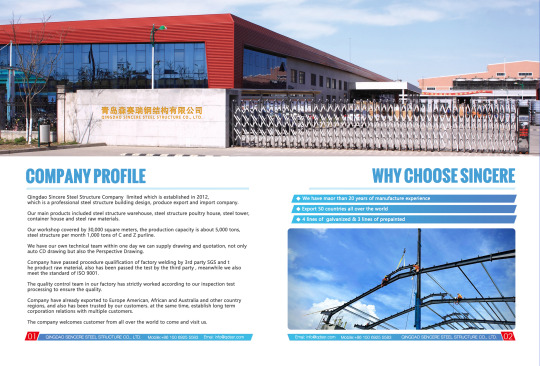#Building (Construction)
Text
Since the 1960s, the world has seen a spike in the number of natural disasters, largely due to rising sea levels and an ever gradually increasing global surface temperature.
The good news? We’re getting better at helping each other when disasters strike.
According to a recent study from Our World In Data, the global toll from natural disasters has dramatically dropped in the last century.
“Low-frequency, high-impact events such as earthquakes and tsunamis are not preventable, but such high losses of human life are,” wrote lead authors Hannah Ritchie and Pablo Rosado.
To conduct their research, Ritchie and Rosado gathered data from all geophysical, meteorological, and climate-related disasters since 1900. That includes earthquakes, volcanic activity, landslides, drought, wildfires, severe storms, and mass floods.
In the early-to-mid 20th century, the average annual death toll from disasters was very high, often climbing to over a million.
For example, the study cites that in 1931, 2.7 million people died from the Yangtze–Huai River floods. In 1943, 1.9 million died from the Bangladeshi famine of 1943. Even low-frequency events had extreme death tolls.
“In recent decades we have seen a substantial decline in deaths,” Ritchie and Rosado observed. “Even in peak years with high-impact events, the death toll has not exceeded 500,000 since the mid-1960s.”
Why has the global death toll from disasters dropped?
There are a number of factors at play in the improvement of disaster aid, but the leading component is that human beings are getting better at predicting and preparing for natural disasters.
“We know from historical data that the world has seen a significant reduction in disaster deaths through earlier prediction, more resilient infrastructure, emergency preparedness, and response systems,” Ritchie and Rosado explained in their study.
On April 6, [2024],a 7.2 magnitude earthquake rocked the city of Hualien in Taiwan. Days later, as search and rescue continues, the death toll currently rests at 16.
Experts have praised Taiwan for their speedy response and recovery, and attributed the low death toll to the measures that Taiwan implemented after an earthquake of similar strength hit the city 25 years earlier. Sadly, on that day in 1999, 2,400 people died and 11,000 were injured.
In an interview with Al Jazeera, Wang Yu — assistant professor at National Taiwan University — said that event, known as the Chi-Chi earthquake, revolutionized the way Taiwan approached natural disasters.
“There were lots of lessons we learned, including the improvement of building codes, understanding earthquake warning signs, the development and implementation of earthquake early warning (EEW) systems and earthquake education,” said Wang.
Those same sensors and monitoring systems allowed authorities to create “shakemaps” during Hualien’s latest earthquake, which helped them direct rescue teams to the regions that were hit the hardest.
This, in conjunction with stronger building codes, regular earthquake drills, and public education campaigns, played a huge role in reducing the number of deaths from the event.
And Taiwan’s safeguards on April 6 are just one example of recent measures against disasters. Similar models in strengthening prediction, preparedness, and recovery time have been employed around the world when it comes to rescuing victims of floods, wildfires, tornados, and so on.
What else can we learn from this study?
When concluding the findings from their study, Ritchie and Rosado emphasized the importance of increasing safety measures for everyone.
Currently, there is still a divide between populations with high gross national income and populations living in extreme poverty.
Even low-income countries that infrequently have natural disasters have a much higher death rate because they are vulnerable to collapse, displacement, and disrepair.
“Those at low incomes are often the most vulnerable to disaster events; improving living standards, infrastructure, and response systems in these regions will be key to preventing deaths from natural disasters in the coming decades,” surmised Ritchie and Rosado.
“Overall development, poverty alleviation, and knowledge-sharing of how to increase resilience to natural disasters will therefore be key to reducing the toll of disasters in the decades to come."
-via GoodGoodGood, April 11, 2024
#good news#hope#climate change#hope posting#climate news#climate crisis#climate anxiety#climate emergency#natural disasters#disasters#earthquake#wildfire#hurricane#cw death#taiwan#tsunamis#building construction#climate action#climate hope
459 notes
·
View notes
Text

This young man from Austin, Texas is making good use of his summer vacation by learning, by the sweat of his brow, how tons of steel become giant skyscrapers, August 21, 1925. He is an iron worker on the new 15-story physics building being constructed at Columbia University. Besides not being afraid to balance himself atop the highest girders, the student iron worker is quite a boxer, fighting under the name of "Wary" Wade, the proceeds of the fight going towards paying his way through college.
Photo: Bettmann Archive/Getty Images/Fine Art America
#vintage New York#1920s#heights#building construction#iron worker#Aug. 21#21 Aug.#1920s New York#vintage NYC#Columbia Univ.#balancing
142 notes
·
View notes
Text

Trinity Church
#photo#my photos#photooftheday#picture#photoshoot#photographer#photograph#photoshop#photography#building construction#buildings#architectdesign#architecture#church architecture#church#churches#european city#europe#sweden#black and white#black and white photography#black and white aesthetic#black and white art#photo art#black and white photo#bnw#gothic#goth aesthetic#gothcore#goth
31 notes
·
View notes
Text
The dolmen pre-dates the main stone circle at Stonehenge in the United Kingdom by about 1,000 years, but the construction process described in the study would have involved similar techniques and demanded a similar level of engineering.
“These people had no blueprints to work with, nor, as far as we know, any previous experience at building something like this,” says study co-author Leonardo García Sanjuán, an archaeologist at the University of Seville in Spain. “And yet, they understood how to fit together huge blocks of stone” with “a precision that would keep the monument intact for nearly 6,000 years”.

Another task that demanded precision and skill was finessing the upright slabs into sockets carved 1.5 metres deep into the bedrock. The laser scans revealed that the builders used counterweights and ramps to move the uprights carefully into the sockets, tilting them at precise, millimetre-scale angles. The stones were carved into facets that meant they locked against their neighbours when the weights and ramps were removed.
7 notes
·
View notes
Text
Sirpi Construction | Sirpi Property Care | Sriperumbudur | Ph. 9787813193
Build your aspirations with Sirpi Construction, located in Sriperumbudur. We provide comprehensive
construction services for both residential endeavors, such as apartments and villas, as well as
commercial projects. Our skilled team focuses on achieving exceptional results in civil and industrial
construction, ensuring your vision comes to life.
#Sirpi#Sirpi Construction#Sirpi Construction in Sriperumbudur#Building Construction#Civil Construction#Construction Company#Apartment Construction#Manufacturing Company Construction#Flat Construction#Park Construction#Home Construction#House Construction#Office Construction#Villa Construction#Interior Design#Commercial Construction#Residencial Construction#Industrial Construction#Factory Construction#Amusement park#Warehouse Construction#Farmhouse Construction#Property Redevelopment#Individual Plot Development#Consultation Design Maintenance#Remodeling Renovation#Floor Plan#General Construction Work#Roofing#partitioning
2 notes
·
View notes
Text

Industrial Factory Construction: A Comedy of Concrete
Industrial factories are the backbone of manufacturing industries, the real unsung heroes of production!
industrial factory construction! It's the art of turning blueprints into buildings and coffee into concrete.
Industrial construction is what makes it possible to buy a microwave dinner and have it ready in three minutes flat. Thank you, factory builders!
Industrial factory construction doesn’t have to be all serious business. With the right team, a sense of humor, and maybe a few extra cups of coffee, you can build the factory of your dreams—and have a few laughs along the way.
Ready to build your next big thing? We promise to bring the expertise, the tools, and a few good jokes to keep things lively.
Contact us today and let’s get started!
Web: plinthandroofs.com
factoryandshed.com
Call: +91-9409271000
#construction#building construction#factory construction#industrialconstruction#peb manufacturers#industrial fabrication#warehouseconstruction#factoryconstructionexperts#industrialshedmanufacture#youtube
2 notes
·
View notes
Text

#original photographer#original photography#original photo#photographers on tumblr#original photography on tumblr#fujifilm camera#fuji camera#fuji xs10#fujifilm xs10#digital camera#digital photography#auto vivitar 28mm#vivitar lens#m42 lens#28mm lens#building#building construction#city#urban#urban decay#building restoration
4 notes
·
View notes
Text





Photo by adamhliva
#inspiration#sky#clouds#golden hour#landscape#building construction#architecture#town#historic architecture#building#city art#city architecture#castle#hungary#Budapest#garden design#garden water features#plants#europe travel#europe aesthetic#tourist attraction
9 notes
·
View notes
Text
The Benefits Of Hempcrete
This is the house that Hemp built.
youtube
The benefits of using Hempcrete in every construction project.
Written by Casper Leitch
The benefits of Hempcrete is that it is a game-changer in the realm of Eco-friendly construction. If you're passionate about industrial hemp, hemp farming, or just want to see our planet thrive, you will be excited by the wonders of this revolutionary building material.
What is Hempcrete? It's a blend of industrial hemp, lime, and water coming together to form a supercharged building material. It's like nature's own recipe for sustainable construction, packed with benefits that go beyond your average brick and mortar.
An example is found in insulation uses. Hempcrete is like a cozy blanket for your home, but better. Its natural fibers create tiny air pockets, acting as a barrier against pesky temperature changes. Whether it's a scorching summer day or a chilly winter night, Hempcrete keeps things just right inside, saving you money on heating and cooling bills.
Hempcrete doesn't just keep you comfy, it keeps you safe too. Thanks to its fire-resistant properties, you can rest easy knowing your home is protected against potential disasters. No need to worry about flames spreading like wildfire, you are protected from fire in building built with Hempcrete.
While most building materials contribute to carbon emissions during production, Hempcrete does the opposite. As it cures, it actually sucks up carbon dioxide from the air, locking it away for good. It's like building your home while giving the planet a big hug.
Why aren't we seeing Hempcrete buildings popping up left and right? It all comes down to outdated regulations and misconceptions about industrial hemp. By spreading the word about the incredible potential of Hempcrete, we can push for policy changes that prioritize sustainability in construction. Imagine a world where every new building is a step towards a greener, cleaner future.
So whether you're into hemp farming, ending hemp prohibition, or just want to see our planet thrive, let's rally together and champion the widespread adoption of Hempcrete. Help educate business leaders and politicians in your community about the benefits, applications, and potential impact on the construction industry and the environment that the use of Hempcrete has.
The Insulation Powerhouse: Unraveling the Secrets of Hempcrete's Thermal Properties
youtube
Let's start by taking a closer look at Hempcrete's insulation capabilities – the cornerstone of its appeal as a sustainable building material. Traditional insulation materials often rely on synthetic fibers that are energy-intensive to produce and may contain harmful chemicals. In contrast, Hempcrete harnesses the natural properties of industrial hemp to create a highly efficient thermal barrier.
At the heart of Hempcrete's insulation prowess lies its unique composition. Made from a mixture of hemp hurds (the inner woody core of the hemp plant), lime binder, and water, Hempcrete forms a lightweight yet durable material with excellent insulating properties. The hemp fibers create a matrix of tiny air pockets within the material, effectively trapping heat during the winter months and repelling it during the summer – a phenomenon known as thermal inertia.
But what sets Hempcrete apart from traditional insulation materials is its ability to regulate humidity levels within a building. Unlike synthetic insulation materials, which can trap moisture and promote mold growth, Hempcrete acts as a natural moisture buffer, absorbing excess humidity when conditions are damp and releasing it when the air is dry. This not only helps to maintain a comfortable indoor environment but also contributes to improved air quality and reduced risk of mold-related health issues.
From an environmental standpoint, Hempcrete's insulation properties offer significant advantages over conventional materials. By reducing the need for artificial heating and cooling systems, Hempcrete helps to lower energy consumption and carbon emissions associated with building operations. Additionally, its natural composition makes it biodegradable at the end of its lifecycle, minimizing environmental impact and reducing reliance on finite resources.
Fire Resistance: Protecting Lives and Property with Hempcrete
In addition to its insulation properties, Hempcrete boasts impressive fire resistance – a critical feature for ensuring the safety and longevity of building structures. Unlike conventional building materials, which may combust or release toxic fumes when exposed to fire, Hempcrete exhibits a remarkable ability to withstand high temperatures without compromising its structural integrity.
The secret to Hempcrete's fire resistance lies in its mineral composition and low density. Lime, the primary binder used in Hempcrete, is inherently fire-resistant and acts as a natural flame retardant. When exposed to heat, the lime undergoes a process known as calcination, in which it releases water vapor and absorbs heat energy, effectively limiting the spread of flames and preventing the material from igniting.
Additionally, the low thermal conductivity of Hempcrete helps to slow the transfer of heat through the material, further reducing the risk of fire propagation. This combination of factors makes Hempcrete an ideal choice for fire-prone environments and high-risk applications where building safety is of utmost concern.
Beyond its immediate benefits for building occupants and stakeholders, Hempcrete's fire resistance has broader implications for public safety and disaster resilience. In regions prone to wildfires, hurricanes, or other natural disasters, buildings constructed with Hempcrete can serve as a protective barrier against external threats, providing invaluable peace of mind to residents and emergency responders alike.
Carbon Sequestration: Fighting Climate Change One Building at a Time
youtube
Perhaps the most compelling aspect of Hempcrete is its capacity for carbon sequestration – the process of capturing and storing carbon dioxide from the atmosphere. While traditional building materials often contribute to carbon emissions during production, Hempcrete operates in reverse, actively removing carbon dioxide from the air as it cures.
The key to Hempcrete's carbon sequestration potential lies in the carbon-negative nature of industrial hemp cultivation. Hemp plants absorb CO2 from the atmosphere during photosynthesis, converting it into biomass that can be used to produce a wide range of sustainable products, including building materials like Hempcrete. When hemp hurds are mixed with lime and water to create Hempcrete, the carbon stored within the plant material is effectively locked away for the lifespan of the building, reducing net carbon emissions associated with construction activities.
But the environmental benefits of Hempcrete don't stop there. In addition to sequestering carbon dioxide during its production, Hempcrete continues to contribute to carbon mitigation throughout its lifecycle. As a highly durable and long-lasting material, Hempcrete helps to minimize the need for frequent renovations or replacements, further reducing energy consumption and carbon emissions associated with building maintenance and disposal.
From an ecological standpoint, the cultivation of industrial hemp for Hempcrete production offers additional environmental benefits, including soil remediation, biodiversity preservation, and reduced reliance on fossil fuels and synthetic chemicals. By choosing Hempcrete over conventional building materials, builders and developers can play a significant role in combating climate change and building a more sustainable future for generations to come.
Overcoming Barriers to Adoption: Navigating Regulations and Changing Perceptions
Despite its numerous advantages, Hempcrete continues to face obstacles to widespread adoption, ranging from regulatory barriers to entrenched perceptions within the construction industry. In many countries, outdated regulations and misconceptions about industrial hemp have limited the use of Hempcrete in mainstream construction projects, relegating it to niche applications or experimental prototypes.
One of the primary challenges facing the widespread adoption of Hempcrete is the lack of standardized building codes and regulatory frameworks governing its use. Unlike traditional building materials, which have undergone rigorous testing and certification processes, Hempcrete is often subject to a patchwork of regulations that vary from region to region, making it difficult for builders and developers to navigate the permitting process and obtain approval for Hempcrete projects.
Additionally, misconceptions about industrial hemp and its association with psychoactive cannabis have contributed to stigma and resistance within the construction industry and regulatory agencies. Despite the fact that industrial hemp contains negligible levels of THC (the psychoactive compound found in cannabis) and is legally distinct from marijuana under most jurisdictions, lingering concerns about legality, safety, and performance have hampered acceptance of Hempcrete as a viable construction material.
However, as awareness of the environmental and economic benefits of industrial hemp continues to grow, momentum is building for policy changes that support the widespread adoption of Hempcrete in mainstream construction. In recent years, a growing number of countries have enacted legislation to legalize hemp cultivation and expand the use of hemp-based products, including building materials like Hempcrete. These regulatory developments, coupled with increasing demand for sustainable construction solutions, bode well for the future of Hempcrete and its potential to transform the built environment.
The Future of Hempcrete: Opportunities and Challenges in a Rapidly Evolving Landscape
youtube
Looking ahead, the future of Hempcrete appears bright, with ample opportunities for innovation and growth in the sustainable construction sector. As builders, architects, and developers continue to seek out Eco-friendly alternatives to conventional building materials, Hempcrete stands poised to capture a larger share of the market and emerge as a mainstream solution for sustainable building projects.
One of the key drivers of growth for the Hempcrete industry is the expanding market for green building materials and sustainable construction practices. With increasing awareness of the environmental and health impacts of traditional construction methods, consumers and industry professionals alike are turning to alternatives like Hempcrete to reduce their carbon footprint and create healthier indoor environments. This growing demand for sustainable building materials, coupled with advancements in hemp cultivation and processing technology, is fueling investment and innovation in the Hempcrete sector, driving down costs and expanding the range of applications for this versatile material.
However, despite its promise and potential, Hempcrete still faces a number of challenges that must be addressed in order to realize its full impact on the construction industry and the environment. Chief among these challenges is the need for continued research and development to optimize the performance, durability, and scalability of Hempcrete as a mainstream building material. While Hempcrete has demonstrated impressive properties in laboratory and small-scale applications, further testing and validation are needed to ensure its suitability for larger, more complex construction projects and diverse climatic conditions.
Additionally, efforts to overcome regulatory barriers and promote acceptance of Hempcrete within the construction industry will be crucial to its long-term success and viability. By advocating for standardized building codes, certification standards, and industry guidelines for Hempcrete construction, stakeholders can create a more supportive regulatory environment that encourages investment, innovation, and adoption of sustainable building practices.
In conclusion, Hempcrete represents a promising solution to the environmental and economic challenges facing the construction industry in the 21st century. With its exceptional insulation properties, fire resistance, and capacity for carbon sequestration, Hempcrete offers a compelling alternative to traditional building materials that is both sustainable and cost-effective. As advocates for industrial hemp, hemp farming, and sustainable development, we have a unique opportunity to champion the widespread adoption of Hempcrete and pave the way for a greener, more resilient built environment. By working together to overcome regulatory barriers, promote awareness, and drive innovation, we can harness the full potential of Hempcrete to create a brighter future for generations to come. Let's build a greener world, one Hempcrete block at a time.
Below is a FREE TO DOWNLOAD marijuana music MP3 by Muck Sticky.
One Day At A Time.
youtube
2 notes
·
View notes
Text
#building materials#building construction#building#construction#business#raw materials#construction materials
2 notes
·
View notes
Text
Spread footing, also known as spread foundation, is a type of shallow foundation employed in construction to evenly distribute a structure's load over a broader area of the underlying soil. It aims to prevent excessive settlement and ensure the stability of the structure.
Types of Spread Foundation
1. Isolated Spread Footing
Isolated spread footing is the most basic type and is widely utilized in construction projects. It supports a single column, distributing the load directly beneath it. Ideal for structures with regularly spaced columns.
2 notes
·
View notes
Text

The new Waldorf Astoria under construction, April 12, 1930. St. Barthelomew’s is on the left. You must enlarge.
Photo: Associated Press via the NY Daily News
#vintage New York#1930s#Waldorf-Astoria#old NYC#building construction#wide-angle photo#Park Avenue#St. Barthelomew’s Church
24 notes
·
View notes
Text

#my photos#photo#photooftheday#picture#photoshop#photographer#photoshoot#photography#photograph#building construction#buildings#concrete#architecture#city#wall#courtyard#church#church architecture#church photography#churches#faith#europe#europe travel#europe trip#monument#sweden#cityscape#places#town#europa
15 notes
·
View notes
Video
youtube
Top 10 Construction Projects Completing in 2024
3 notes
·
View notes
Text
Immediate Hiring Business Development Manager
SALARY - 40to 60k PM
JOB LOCATION - Delhi & Gurgaon
INDUSTRY - Building Materials, Tiles, Door and Windows
Exp- Minimum 3Years
Call Now @ 8188998866 , 8188998899 ( WhatsApp)
Email your Resume [email protected]

#job#best jobs#jobs#job interview#jobsearch#lucknow#career#jobs from home#marketing strategy#businessgrowth#b2b#building materials#building plans#building construction#architecture#tiles manufacturer#sales jobs
4 notes
·
View notes
Text

Company exported steel structures to Africa
Recently, the price of steel structure raw materials is at an advantageous stage, which greatly stimulated the enthusiasm of customers for purchasing.
youtube
3 notes
·
View notes